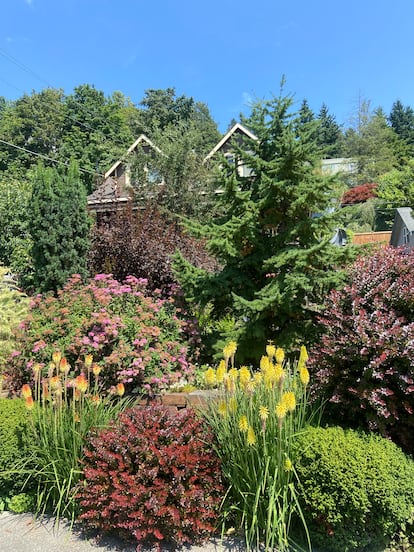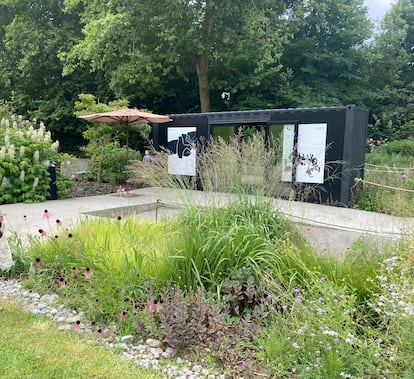Why are perennial gardens so popular? Because they are vibrant and enduring landscapes
Herbaceous perennials are the foundation of modern landscaping and the driving force behind the ‘New Perennial’ movement — to know them is to love them

Every year, right before spring arrives, there’s a magical moment in a garden when anything seems possible. It’s also when perennial plants take center stage. Perennials are herbaceous plants that lose their stems, flowers and leaves in winter, but their roots stay alive underground and sprout again in spring. This diverse group of plants has gained popularity among gardening enthusiasts for several decades. In recent years, the New Perennial movement and influential designers like Piet Oudolf have made it even more trendy. In Spain, Fernando Martos applied a natural approach to the terraces of the Royal Botanical Garden in Madrid.
Vibrant compositions create ever-changing landscapes, embracing textures, volumes and chromatic nuances that evolve with the seasons. Perennial gardens are sustainable, resistant to frost and drought, and provide habitat for native species. They remain captivating from spring to winter, making them a cornerstone of contemporary landscaping. The captivating work of Oudolf, Martos and their legion of colleagues who embrace the New Perennial movement has become the cornerstone of contemporary landscaping. Botanical tourism and social media have also fueled the popularity of perennial gardens.
“In the past, gardening and landscaping enthusiasts used to subscribe to French and English magazines to learn about the beautiful perennial gardens of France, Holland and the United Kingdom. Nowadays, with so much more travel and opportunities to visit gardens, many Spanish landscapers have embraced the versatility and sustainability of these plants,” said Marián Parra, a biologist at the Atlantic Botanical Garden in Gijón (northern Spain).
Imperfectly perfect
To create a perennial garden, it’s important to change one’s perspective. The traditional notion that gardens fade away in winter doesn’t apply here. In fact, it’s quite the opposite. Perennials hold their beauty throughout the seasons, even in fall and winter. By combining them with evergreen shrubs, grasses and bulbs that bloom at different times, a garden can maintain its structure and appeal all year round.

During winter, perennial plants undergo a life-cycle stage where their above-ground parts dry up or disappear completely. Recognizing this as part of their natural cycle, these charming herbaceous perennials offer great design opportunities. Some perennials like garlic (Allium millenium) and thistle (Cynara cardunculus, Dipsacus fullonum) maintain their beauty even as they fade, prompting many gardeners to leave them untouched until winter’s end. The same applies to grasses such as miscanthus, pennisetum, calamagrostis, and stipas, which form graceful clumps that sway in the wind and sparkle when covered in frost. By embracing these plants, gardens can offer a longer aesthetic appeal and a continuous cycle of beauty that extends to their rejuvenation in spring. Meanwhile, deciduous plants like geraniums and anemones completely dry out in winter. “You can gather the stems and leaves to make compost or leave them in their beds so they decompose and enrich the soil,” said Parra.
Garden blends with natural rhythms
You don’t have to get fussy about a garden with perennial plants that shed their leaves. “One option is to mix them up with bulbs,” said Parra. “So, during winter when the perennials haven’t sprouted yet, the bulbs will start producing stems, followed by lovely flowers. In December, you’ll have green leaves, followed by cyclamen flowers in January, crocuses and daffodils in February, and tulips in March. Gradually, the leaves of the perennials will begin to appear, and when the bulb plants fade away, the perennials will take center stage. It’s a great way to have plants every year without spending a lot of time and money on annuals.”

Perennials can also be placed on balconies and small terraces. Simply choose compact, small-scale cultivars that can be planted in pots and let yourself be inspired by the textures of Salvia microphylla, Stipa tenuissima Pony Tails, Pennisetum alopecuroides, Nepeta faassenii Walker’s Low... Consider plants with striking shapes like Kniphofia uvaria and vibrant flowers (Tulbaghia violacea, Salvia yangii Little Spire, Achillea millefolium, Convolvulvus cneorum, Helleborus niger). And add a few with interesting foliage (Alchemilla mollis, Agapanthus africanus).
Perennials are not just visually appealing — they are revolutionizing contemporary gardening. These plants are transforming the way we perceive domestic landscapes by promoting environmental awareness and sustainability during the drier winters and hotter summers brought on by climate change. We now prioritize plants that provide shelter and food for birds and insects, recognizing their crucial role in biodiversity. The seasonal garden cleanup is becoming less rigorous, with meadows replacing traditional lawns. Many people now delay mowing stems and thistles, allowing hollow stems and fruit husks to serve as habitats and food sources for wildlife. Then, as spring draws near, garden enthusiasts await the captivating perennial show that always brims with infinite potential.
Sign up for our weekly newsletter to get more English-language news coverage from EL PAÍS USA Edition
Tu suscripción se está usando en otro dispositivo
¿Quieres añadir otro usuario a tu suscripción?
Si continúas leyendo en este dispositivo, no se podrá leer en el otro.
FlechaTu suscripción se está usando en otro dispositivo y solo puedes acceder a EL PAÍS desde un dispositivo a la vez.
Si quieres compartir tu cuenta, cambia tu suscripción a la modalidad Premium, así podrás añadir otro usuario. Cada uno accederá con su propia cuenta de email, lo que os permitirá personalizar vuestra experiencia en EL PAÍS.
¿Tienes una suscripción de empresa? Accede aquí para contratar más cuentas.
En el caso de no saber quién está usando tu cuenta, te recomendamos cambiar tu contraseña aquí.
Si decides continuar compartiendo tu cuenta, este mensaje se mostrará en tu dispositivo y en el de la otra persona que está usando tu cuenta de forma indefinida, afectando a tu experiencia de lectura. Puedes consultar aquí los términos y condiciones de la suscripción digital.
More information
Últimas noticias
Most viewed
- Sinaloa Cartel war is taking its toll on Los Chapitos
- Oona Chaplin: ‘I told James Cameron that I was living in a treehouse and starting a permaculture project with a friend’
- Reinhard Genzel, Nobel laureate in physics: ‘One-minute videos will never give you the truth’
- Why the price of coffee has skyrocketed: from Brazilian plantations to specialty coffee houses
- Silver prices are going crazy: This is what’s fueling the rally









































